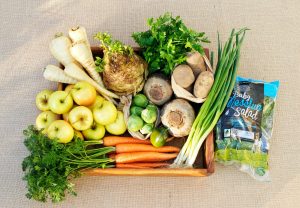 There is no clear definition of a vegetable, but what we call vegetables are generally one of a few parts of a plant: fruit or flower; leaf or shoot; root or tuber. Leaves and roots clearly look very different, but both are critical to the survival of plants: leaves take in energy from the sun, while roots seek nutrients and water from the soil and store the energy collected from the sun in the form of carbohydrates. What we see as different vegetables can actually be different parts of plants that are virtually the same.
There is no clear definition of a vegetable, but what we call vegetables are generally one of a few parts of a plant: fruit or flower; leaf or shoot; root or tuber. Leaves and roots clearly look very different, but both are critical to the survival of plants: leaves take in energy from the sun, while roots seek nutrients and water from the soil and store the energy collected from the sun in the form of carbohydrates. What we see as different vegetables can actually be different parts of plants that are virtually the same.
If you’ve noticed a similarity between the flat-leaf parsley and the leaves on your bunched carrots this week, it’s because carrots, parsley – and indeed parsnip – are all closely related. Whilst each vegetable has been cultivated for particular properties and are now distinct, you can definitely eat carrot tops – they do have a somewhat parsley-like flavour – and “root parsley”, which as the name suggests is the root of a parsley plant, is very similar to parsnip and is a popular vegetable in Europe. Silverbeet and beetroot are similarly related, although it’s easier to see when comparing bunched beetroot with silverbeet, and whilst silverbeet roots aren’t a culinary winner, beetroot leaves are definitely delicious, although a bit stronger in flavour.
Celeriac is sometimes referred to as celery root, which is not technically correct, but if your celeriac this week has little stalks of celery growing out of the top that’s because they’re closely related, and the fairly tough little stems coming out of the root are evidence of the way the plant has been cultivated to prioritise a large, carbohydrate-rich root in preference to crisp, elongated and watery stems.
The three brassicas included in boxes this week – broccoletti, cauliflower and Brussels sprouts – are of course closely related to each other too, and we eat and cultivate for different parts of these: cauliflower is all about – as the name suggests – the flower, broccoletti is eaten for both the stem and flower, where Brussels sprouts, which look like a tight-leaved cabbage, are actually buds at the base of the leaf stems, but actually produce a “crown” – which rarely finds its way to the retail market – at the top of the main stalk which is actually a true cabbage.

